Featured Professional
Kissing spines has a reputation for causing severe back pain. But for many horses diagnosed with this condition it isn’t necessarily bad news, as vet Laura Quiney, from the Animal Health Trust, explains.
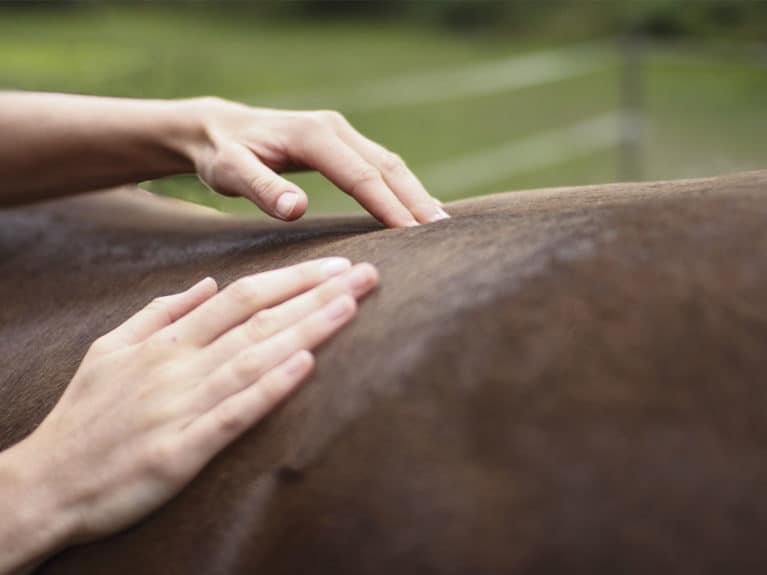
Our expert – Laura Quiney BVSc MRCVS is Junior Clinician at the Animal Health Trust. She’s particularly interested in lameness, poor performance evaluation and equine diagnostic imaging, especially radiography and magnetic resonance imaging.
A diagnosis of kissing spines usually fills owners with dread, as we’ve all heard of horses who have the condition who’ve become too dangerous to ride – sometimes permanently. Called impinging spinous processes by vets, it’s a relatively common condition that can affect the vertebrae in your horse’s back.
Spinous processes are pieces of bone that extend from the top of each vertebrae and in a normal horse there’s a space between each. However, in horses with kissing spines, these spinous processes touch or overlap.
It’s true that kissing spines can cause a lot of pain, but did you know that many horses with kissing spines suffer no discomfort at all? Often it’s an incidental finding while investigating another problem. So if your horse has kissing spines, it’s not all doom and gloom.
Causes of kissing spines
Horses with short or dipped back conformation will inevitably have spinous processes that are crowded or close together. Crowding doesn’t necessarily lead to kissing spines or pain, however the flexibility of your horse’s back may be reduced. It’s unlikely that this will affect his ability to work unless he’s competing at a high level, although this stiffness may predispose him to back muscle or ligament pain, or damage to the joints of his spine or pelvic region.
The back is a dynamic structure and the closeness of the spinous processes will also be determined by back posture. For example, when your horse is ridden in a correct or long and low outline, the spinous processes probably have a larger gap between them than when he’s ridden incorrectly, with his head above the bit and back hollow or dipped.
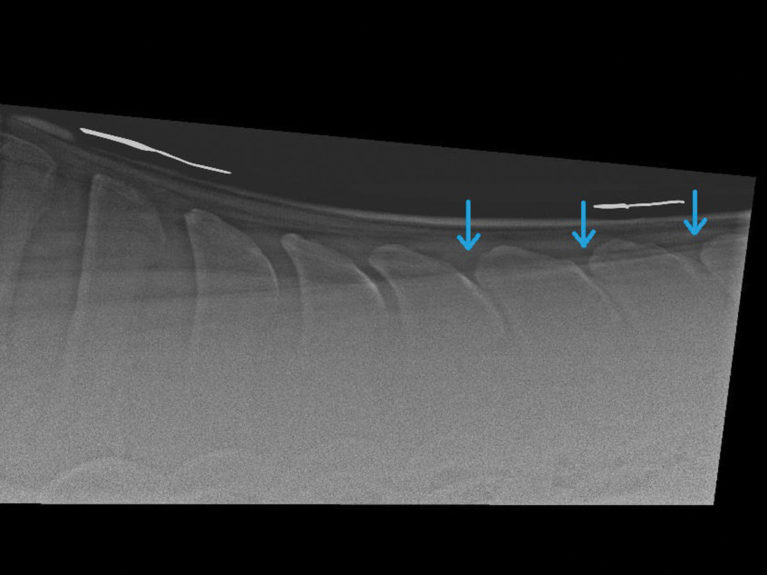
Alternative causes of back pain
Just as a diagnosis of kissing spines on X-ray doesn’t necessarily mean pain, back discomfort doesn’t always mean your horse has kissing spines. Tension, pain or stiffness in the back is common in ridden horses, and because signs of discomfort are more obvious when horses are ridden, it’s often assumed that the back is the primary problem. However, in the majority of cases it’s secondary to another problem, such as…
- an ill-fitting saddle that may cause back pain because of pressure points if the panels bridge (make contact at the front and back, but not in the middle), or it pinches, or tips backwards or forwards. If the saddle tends to slip to one side then, as well as leading to uneven weight distribution across the muscles of the back, the panel on the opposite side to which the saddle slips may press on the spinous processes, causing pain
- a heavy rider, one who has poor balance, or one who struggles to ride their horse in a correct or long and low outline may also induce back pain
- pain elsewhere in the body, such as lameness. Tension or pain in the back is often one of the first signs an owner notices when there’s discomfort somewhere else in the body. Lameness appears to alter the biomechanics and movement of horses’ backs, which can lead to muscle tension, pain and muscle wastage as a result of reduced muscle use.
When ridden, horses with pain elsewhere in their body may hold their back stiffly and resist bending one or both ways. Lameness when ridden can also cause some horses to display conflict behaviour, such as bucking – this can be an important sign of pain if your horse didn’t previously buck when ridden. Negative associations between ridden exercise and lameness may also cause your horse to resent being tacked up, girthed or mounted, despite having no primary back problems.
Did you know?
While an unevenly flocked saddle may tip to one side, research carried out by the Animal Health Trust has identified hindlimb lameness as the major cause of saddle slip.
Signs of back pain
Whether back pain is caused by kissing spines or as a result of secondary back pain, the signs include…
- your horse may show pain when his back muscles are examined or resent being asked to flex and extend his back
- depending on the duration of the problem, his back may be poorly muscled, but this can also be seen in horses without back pain
- when lunged, your horse may hold his back stiffly and you may be able to see that his back muscles are tightly contracted
- he may resent being tacked up or mounted, show cold-backed behaviour, buck or have a stiff back when ridden, however, these can also be signs of lameness
Did you know?
When a horse has kissing spines, signs of pain tend to be worse when he’s ridden, particularly in sitting rather than rising trot.
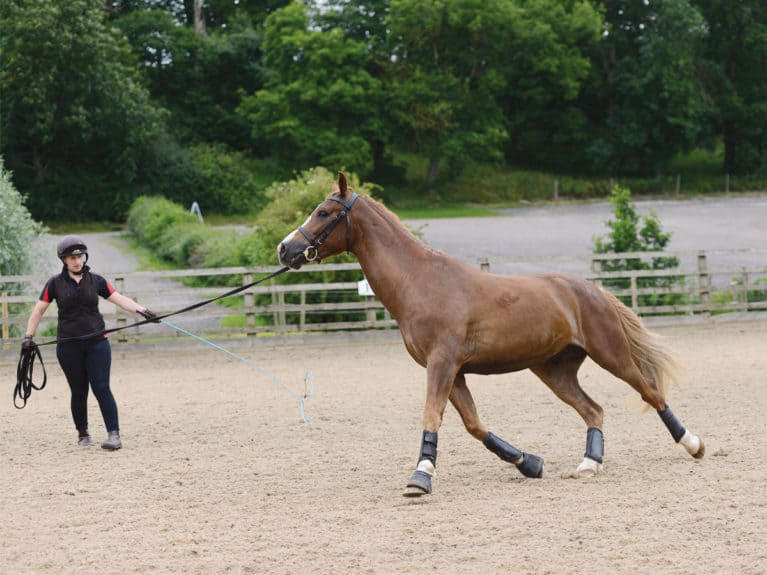
Is kissing spines the problem?
If mild lameness is seen in a horse who appears to have back pain or stiffness, it’s usually best to investigate the lameness first. If the lameness is resolved following nerve blocks, many horses will move much more freely through their back, which indicates that the back stiffness was secondary.
If kissing spines is suspected, X-ray is the best way to confirm their presence. However, portable X-ray machines often struggle to generate enough power to image anything below the very tops of the spinous processes due to the thickness of the surrounding muscle, so your horse may have to have the X-rays taken in a hospital environment.
Even if kissing spines are detected, it’s important to remember that they don’t always cause pain, so they may not be the source of the problem. However, in general, the greater the number of kissing spines and the greater the severity of secondary bony changes, the more likely they are to be causing a problem.
It’s essential that the significance of the kissing spines is established in all cases. The only reliable way to do this is to inject local anaesthetic around the problem vertebrae and assess your horse when ridden afterwards. If the signs of pain have resolved, this indicates that the kissing spines are causing pain. If there’s no obvious improvement, then this means they aren’t the underlying problem.
It’s possible for a horse to have painful kissing spines and lameness. In this instance, your horse may show a significant but not complete improvement to the local anaesthetic, so further nerve blocks should be performed to find the cause of the lameness. It’s therefore important that in all cases of back pain a thorough lameness evaluation, including ridden exercise, is carried out in combination with comprehensive nerve blocking.
Nuclear scintigraphy (bone scan) has been used to assess the activity of kissing spines. A radioactive substance is injected into your horse’s bloodstream and binds to bone, particularly if the bone is actively remodelling. This shows up as a hot spot. However, hot spots on bone scans don’t necessarily equate to pain and this technique can give false positive and false negative results, so it can’t be reliably used in place of a thorough lameness examination and blocking with local anaesthetic.
Treatment options
If your horse is diagnosed with kissing spines and your vet is confident they’re causing the problem, pain reduction and improving his posture are the two major aims of treatment. There are several options that can help to reduce pain and which one is chosen depends upon the degree of pain, severity of the problem, and type and level of work expected from your horse.
Medical options usually require multiple treatments and include…
- extracorporeal shockwave therapy (pulses of high-pressure mechanical energy). This is a non-invasive technique that has a pain-relieving effect
- mesotherapy, which involves multiple small injections into the skin. The aim is to reduce the transmission of pain through the nerves
- injecting corticosteroids around the kissing spines can reduce pain and inflammation
Surgery is also an option, and can be used for horses who haven’t responded satisfactorily to medical management and rehabilitation, or those with severe lesions that are unlikely to respond to any non-surgical treatment.
There are different types of surgery that can be performed, but all aim to widen the gaps between the affected spinous processes. Surgery can now be done while your horse is standing and under sedation, so there’s usually no need for a general anaesthetic.
With correct diagnosis and if there are no other causes of pain contributing to your horse’s poor performance, the prognosis for his return to athletic activity is good.
Management of horses with kissing spines
Whether your horse is treated medically or surgically, it’s important that it’s combined with a physiotherapy programme designed to improve his posture and core muscle strength. In addition to this, you can help your horse by…
- regularly refitting his saddle
- assessing rider weight and balance
- feeding him from the ground
- working him in a Pessoa training aid or similar to strengthen his core muscles and improve the flexion in his back
- riding him in a correct or long and low outline, and avoiding dipping of his back
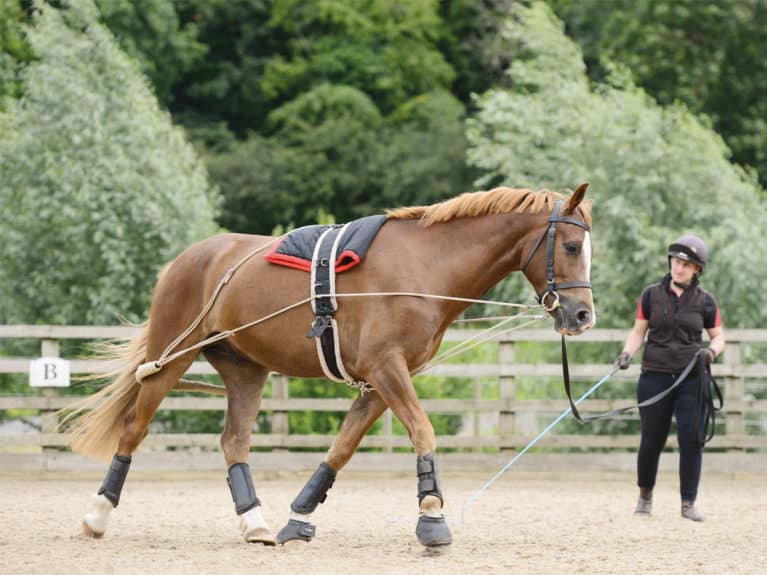
Protecting against kissing spines
Whatever your horse’s back conformation, it’s wise to take preventative measures to keep it in good working order. Take steps to improve and maintain good back posture and stability, and ensure he’s always ridden in a correct outline or long and low. This will help to keep the spinous processes apart, and go a long way to reducing the chance of him suffering from kissing spines and back pain.
Your Comments
6 thoughts on “Kissing spines – too close for comfort”
Leave a Reply
You must be logged in to post a comment.







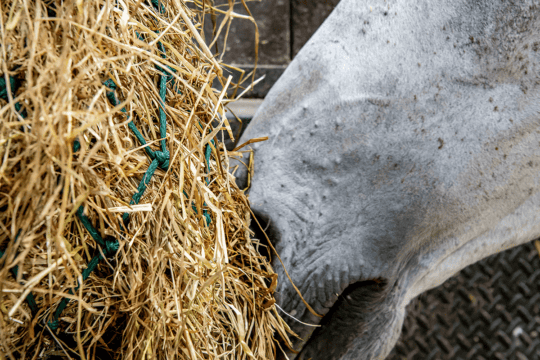






our 11 yr old thoroughbred was just diagnosed with mild kissing spine. my daughter does eventing with him. he has had back pain for 2 wks now and vet checked for ticks and was negative. xrays showed a mild case of kissing spine but my concern is that he is now too sore to ride I think. What are your thoughts on this? Thank you
Maggie
Hi Maggie, the best person to advise on this case would definitely be your vet and your physiotherapist. They’ll know what’s best for your horse and how o manage his condition. Good luck!
My 23 year old Hanoverian gelding has for years displayed angry/resistant behavior around saddling and in particular blanketing. This has persisted despite the weight of the sheet or blanket to the point he piaffes in the crossties while nearly rearing at times. Once the sheet is on his back he settles down but really hates blankets. If I even pick one up in the aisle and walk toward him, he pins his ears. He is also very grumpy in his stall and food possessive. He is not being ridden due to my own health limitations and I want to make him comfortable but I feel things are behavioral too at this point. He is very happy when out grazing and easy to handle overall . Just wondering if his attitude/behavior sounds consistent with kissing spine. He gallops out to his field and is relatively sound otherwise. Thanks! Jen
We have a 7 y.o. thoroughbred with kissing spine. Hung badly on the track. Very sore over back. Literally went very lame in the hind legs over night, reluctant to move. Xrays confirmed K,S, He still gallops, bucks, carries on in the paddock like there is nothing wrong with him. Severely lame though when worked even without rider.
My name is Sally and I am concerned. A horse I am training has alot of trouble moving forward and often gets stuck or goes back wards. He’s been abused before so I considered this behavioral. Also it’s gotten better and sometimes goes away totally. Yesterday was the first time I saw a sign of pain. When I got on him he real quick did a mini version of everything bad a horse can do at mounting then he stood still. I got off and lunged him and when I got back on he was fine but whinnying alot which he never does. I didn’t ride long no bad behaviour. When I turned him out he galloped off like a nut. Which is also unusual. Spring fever or kissing spine. My horse will not go forward has major trouble maining a trot though he will and is. Incapable of maintaining a canter. He is 9 years old and has had threeonths under saddle other than an abusive experience for a number of weeks years ago. Help. Kissing spine?
I lease a 14 y.o. warmblood mare who started bucking, rearing, and kicking at me all of a sudden. I told my instructor (she owns the horse) but she said it was mental. She’s been bucking and bolting at least 5 times whenever I ride her. I talked to my instructor again and she said it was my energy that was causing her to buck. A few days later I had all of my riding friends (who have been riding for many more years than me) get on her and she was way, way worse. I did some research and I think it’s kissing spine. My trainer also refuses to ride her which made me think that she didn’t want to find out that it was not mental (she has too many horses and doesn’t. So, yeah. If you have any advice please share!